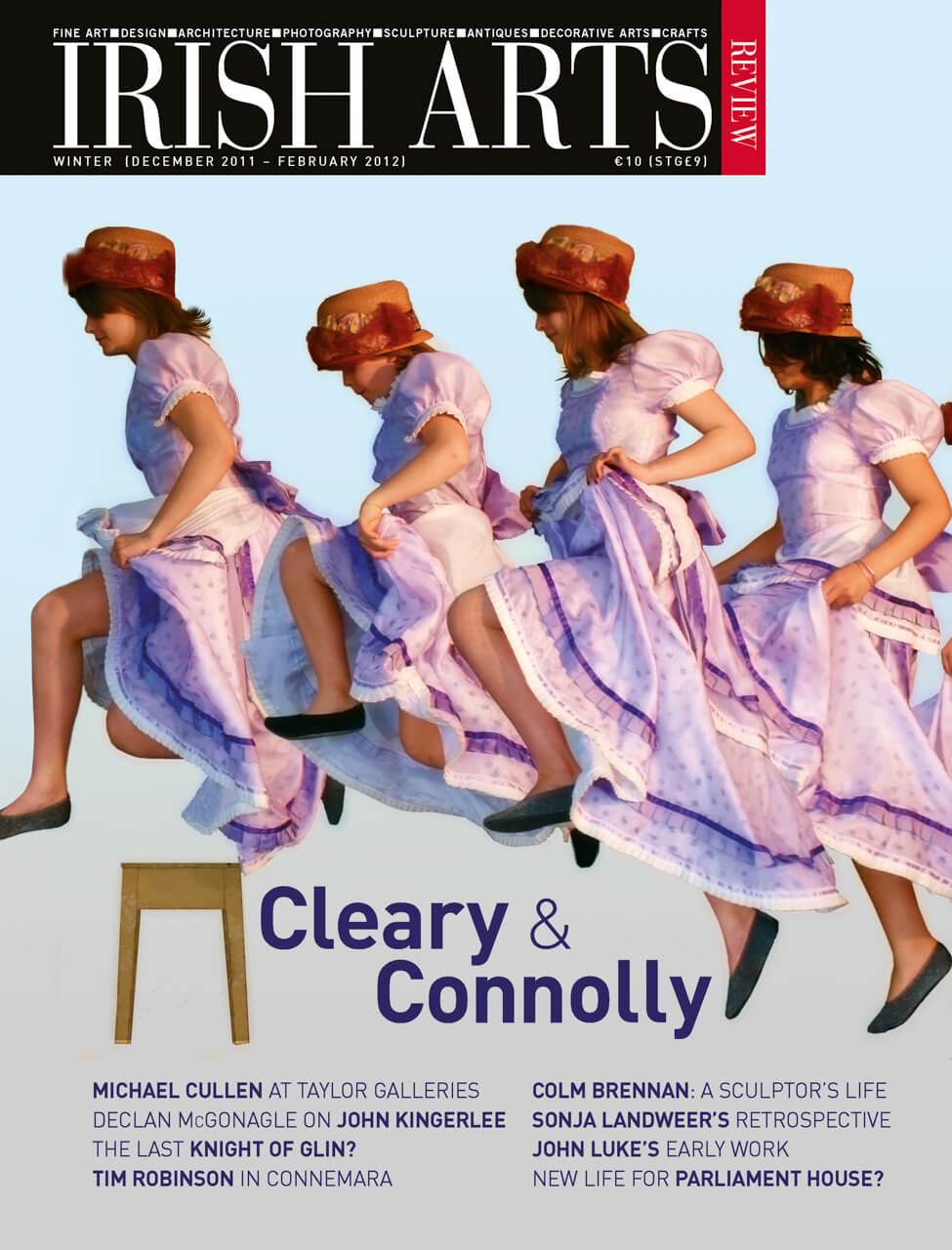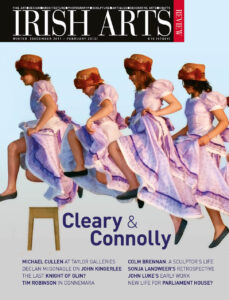

Ireland’s most highly regarded architectural emigre was the subject of a new publication and a USA based exhibition in 2012 Ellen Rowley looked at his legacy in this article which first featured in the Winter 2011 edition of the Irish Arts Review
Kevin Roche (b.1922) is rightly considered to be one of America’s leading architectural forces. Since the early 1960s, he has been at the forefront of architectural design and technology in the dynamic climate of mid to late 20th-century America, developing such projects as the Oakland Museum, California, 1961-8, the Ford Foundation Headquarters, New York, 1963-68 (Fig 2) the Knights of Columbus Headquarters, New Haven CT, 1965-69, or the Union Carbide Corporation Headquarters (Danbury CT, 1976-82).
Roche’s biography is pointedly of its time: it charts the journey of a young Irishman who – following his education at University College Dublin and periods working in the renowned modernist firms of Michael Scott (Dublin) and Maxwell Fry (London) during the later 1940s – travelled to post-war America where he studied briefly with the iconic German modernist Ludwig Mies Van der Rohe in Chicago, worked on phase 1 of the United Nations complex in New York and then, in 1950, joined the seminal firm of Eero Saarinen and Associates in Michigan. Here Roche worked closely with Saarinen, learning his trade, until the latter’s untimely death in 1961, whereupon Roche and a partner in the firm, John Dinkeloo (1918-81), spearheaded the practice.
Together Roche and Dinkeloo (KRJDA) brought Saarinen’s unfinished projects to completion – for example, the boldly modern Jefferson National Expansion Memorial (St Louis Gateway Arch, 1947-68). The partnership grew through the 1960s and 1970s becoming the architectural choice for corporate and cultural America alike, for example, One United Nations Plaza (Fig 3), is a mixed-use complex comprising offices and a hotel within a 39-floor tower which Roche was commissioned to design some twenty years after working on the site of the original UN building. According to accounts, KRJDA’s success was underpinned by a fruitful process with Roche as designer, responding to the requirements of the client through contextual design, and Dinkeloo reacting to that design with technological brilliance. The result is a body of buildings marked out by their large-scale and their clarity of form(s). This monumentality and also technocratic tendency characterize KRJDA’s multifarious commissions from 1961, leading architectural critic Vincent Scully to state in 1974: ‘Roche-Dinkeloo have been dealing with the truly inhuman scale of modern corporate society as it actually is, and have been creating arresting images of it which reveal more about it to us than we knew before.’
While such an architectural biography is engaging, it becomes fascinating to us when we reflect on Kevin Roche’s Irish origins. Unable to contain ourselves in the face of global success, the local flag is pulled out and waved about. We have tried to tether Roche to the Irish mantle, crowning him with the dubious title of ‘Irish architect in America’. From 1969 and through the 1970s, controversial Dublin-architect Sam Stephenson made repeated trips to Roche’s Connecticut office in search of inspiration; in 1977, Roche was made Honorary Fellow of the Royal Institute of Architects of Ireland; and when in 1982 Kevin Roche was awarded the Pritzker Prize (the highest international accolade in architecture), the community of Irish architects responded with a Roche exhibition and publication. But it is only now, almost thirty years on from the initial celebration of Roche as ‘Ireland’s ultimate architectural export’, that we are able to experience something of the force of Roche’s architecture in Dublin’s new Convention Centre (Docklands, 1995-2010). Indeed, as the National Convention Centre settles by the Liffey, Scully’s 1974 reference to ‘inhuman scale’ begins to have resonance with Dubliners.
Generally speaking, the Irish public seem to be quizzically charmed by the Convention Centre (Fig 6). Here, Las Vegas meets the Liffey. Bursting out of its giant rectilinear bulk is an outlandish glazed funnel, articulated at night by looping neon bands. We’re not used to such urban theatricals, though with the simultaneous completion of Santiago Calatrava’s Beckett Bridge now linking Roche’s flashing funnel to Martha Schwarz’s electric red ‘trees’ and Daniel Libeskind’s metallic theatre, Dubliners are quickly adapting to the drama.
The timing of Roche’s first Irish building is unfortunate. Opening just when the hangover from the Celtic Tiger party really kicked in, it has come under scrutiny from all quarters – everyone has questions. Not everyone in the architectural community is charmed by the neon whimsy, the sumptuous interior furnishings or the building’s hulking scale and naive form. They question why a free-standing building has only one front; with the exception of the riverside dialogue, how can an accomplished architect ignore all other urban conversations, leaving the neighbourhood with two vast warehouse-like walls? Acquaintance with some of Roche’s early work such as the markedly contextual Oakland Museum just leaves more questions. Is Roche’s architectural practice too complex to comprehend, or too protracted to categorize? In light of this, the publication of Yale University’s monograph on Roche Kevin Roche: Architecture as Environment (2011) is timely for the Irish audience. Hopefully, the answer to the conundrum that is the Irish Convention Centre lies in understanding Roche’s life-work as presented by Yale. In the foreword, Robert Stern outlines how this new Roche study follows on from the Eero Saarinen monograph, Shaping the Future (2006): taken together the publications reconsider ‘the entire trajectory of American architecture in the second half of the twentieth century.’ Straight off Roche is placed in an American context, is inextricably linked to Saarinen and is presented as a leader of the third generation of American modernist architects. We learn that the book accompanies a travelling exhibition and as such, we expect it to be full of previously unseen drawings and notes: the behind-the-scenes treasure trove of fifty years of architectural design. However, it quickly becomes apparent that the project is too pragmatic for such frivolities. Edited and curated by Eeva-Liisa Pelkonen, the book comprises her introductory essay and three thematic essays – on museums by David Sadighian, on office spaces by Olga Pantelidou, on gardens/green atria by Kathleen John-Alder – as well as a synopsis of Roche’s works 1961-2010 and excerpted interviews with Roche.
Pelkonen’s essay is the book’s highlight. She puts together an eminently readable narrative: her tone is balanced and language accessible. It is long enough to range satisfactorily over Roche’s career, mapping design tendencies along the way. Evidently Pelkonen has struggled to contain and understand Roche’s portfolio, calling him the ‘quintessential architect of the post-industrial age’ who delivers ‘unpredictable structures for unpredictable times’. Setting up the problems, she tackles them issue-by-issue and situates Kevin Roche and his perplexing traits in relation to his classical (Beaux-Arts) training in UCD, which disappointingly is not explored, and more so in the fact that Roche jumps between a classical/rational approach and a modernist/utopian one. I for one am not convinced by such binaries.
Clearly the only consistent element within KRJDA’s oeuvre is its inconsistency. I now recognise the heroism of this tricky position, as Pelkonen repeatedly emphasizes, Roche approaches each design project in its own terms. She explains how for every commission he grapples with ‘programmatic needs, circulation patterns, zoning laws, infrastructural requirements, building codes, traffic flows, urban morphologies, and daylight conditions.’ As a result then, buildings do not look similar. Ultimately, the process of designing is much more important than the objecthood of the designed outcome. We remember that Roche strayed from Mies van der Rohe’s tutelage in 1948 because the young architect needed to learn how to ‘engage the world around him’. He then came to work on the UN site in New York, revealing what seems to be at Roche’s core – social conscientiousness and disdain for pretentiousness.
Bit by bit, Pelkonen picks away at the jarringly corporate aesthetic of the buildings in an attempt to get to this core. The other essays complement Pelkonen’s quest in a limited way – Pantelidou’s workflow study is plodding but informative around Roche’s fascinating method for the Union Carbide commission (he interviewed 300 workers in pursuit of the right design); Sadighian’s museum piece is superbly written and illuminates the layered process of the Oakland (Fig 5) and Metropolitan Museum, New York, masterplan 1971-ongoing (Fig 4); and John-Alder posits Roche as a proto-eco architect but gets bogged down in inappropriate landscape theory. While these three essays do hold a more forensic lens over certain key projects, away from Pelkonen’s overview, they strike me as missed opportunities. There is not enough archival material. With Roche approaching his 90th birthday and still working, along with the donation of his papers to Yale, the reader expects to be bombarded with original objects; letters, sketches or at least to have an intimate sense of the man/designer. If anything, this book feels more remote than previous reflections on Roche such as Francesco Dal Co’s 1985 monograph or indeed, Shane O’Toole’s unassuming 1982 exhibition catalogue. Considering the profound intelligence of Roche’s voice, the Yale interview is disappointedly truncated. I suspect Pelkonen sought to avoid repetition with other Roche-related projects and anticipated that his voice would filter through the essays.
The big surprise and excitement in this 2011 retrospective, which further explains Roche’s work ethic and design process, are the colourful presentation diagrams painted from 1961 onwards. When examined these gouaches and oil paintings – which were photographed, then shown to clients as slide presentations – of roof plans or room flows or streetscape views are shocking. They anticipate CAD and powerpoint by forty years! They are powerful objects, beautiful in their own right, which illustrate the relevance for Roche of communication in architecture. Consistently he has spoken about the inept language of architectural drawing, using instead these diagrams, charts and full-scale interior mock-ups and models as his tools. We begin to realize how pioneering and more plainly, how hard-working he was. Also, we gain insight into how Roche is armed against the intimidation of huge projects – it boils down to organization and empathy. Evidently Pelkonen is buzzed by Roche’s ‘iconography’, linking the diagrams to 1960s systems theory and Roche’s methods to post-formalism and communitarianism, all of which makes for a fascinating read. But none of it really answers the conundrum of Ireland’s only Kevin Roche building, the National Convention Centre. Like many of the recent buildings, the Dublin structure is barely referenced in the book. It is illustrated by a thumbnail image and some cursory descriptive text as part of the 136 projects in the dizzying portfolio of work. The suggestion of problems around the project lurks in its drawn-out nature (1995-2010), and also in the nearby illustrations of an unbuilt hotel for the back of the Convention Centre and, more alarmingly, of an unbuilt inverted ziggurat for Anglo-Irish bank (see pages 247 & 250). No wonder Roche remains disillusioned by his recent Dublin venture.
Kevin Roche’s oeuvre is so vast and varied that it defies definition. Inevitably property developers were his clients at various junctures, but seeing Oakland Museum alongside Unicef HQ New York, 1984-7 is like putting Dublin’s Central Bank (Stephenson, c.1978) and the IFI (O’Donnell, c.1992) in the same category. Essentially, and the Yale book does not convey this, Roche comes from a generation of Irish men who are modest and reticent to reflect. The apparent contradiction arises when you match this reticence with American ambition and work ethic. Maybe Kevin Roche is ‘the Irish architect in America’ after all?
Kevin Roche: Architecture as Environment by Eeva-Liisa Pelkonen (2011) Yale ISBN 978-0-30015223-4 €52.00/ £45.00.
The accompanying exhibition was at the Museum of the City of New York, until 22 January 2012.
Ellen Rowley is assistant editor of Irish Architecture 1600 – 2000 (RIA, Yale, 2014).
From the IAR Archive
First published in the Irish Arts Review Vol 28, No 4, 2011



